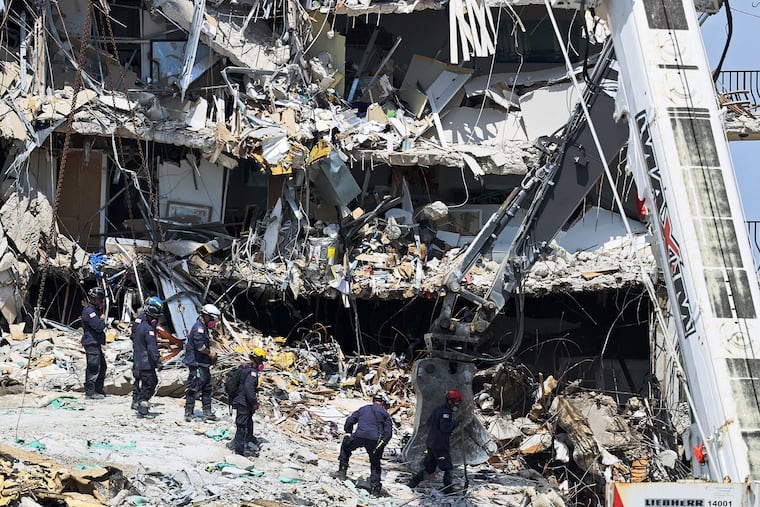To avoid a Surfside tragedy in Philly, building codes need scrutiny now | Opinion
Building owners and developers often see building codes as an obstacle to overcome, but their intention is to protect building occupants.

It seems trite to call the collapse of the Champlain Tower South building in Surfside, Fla., tragic, yet that is the closest description I can offer. I cannot pretend to imagine the sorrow and horror experienced by those affected by this event. As the rescue and stabilization efforts continue, it is only natural to wonder — how did this happen? And can it happen here?
Officials will need months to investigate the root cause (or, more likely, causes) in this case. I do not intend to speculate on the cause here, but generally speaking, buildings fail due to a compromised skeleton, or structure. Issues can come from sources that aren’t readily observable on the surface. The cause can be from outward forces, such as wind, snow, heat, or soil settlement. Faulty water-shedding or improper maintenance can also cause corrosion of structural members over time. One may only look to the Grand Canyon to see what water and time can create.
Why did the building codes not prevent this, you may ask.
Building codes are updated, generally, every three years. Building codes are a minimum standard to which a structure can be built. Pennsylvania adopted the International Building Code (IBC) as its uniform code in the state about 20 years ago. Recently, a review council approved adopting the 2018 edition and should transition early next year to that newer set of rules. Philadelphia is already designing and building commercial structures to the 2018 standard. Back in 2018, with Pennsylvania’s largest code updates in nearly a decade, the state legislature gave Philadelphia the opportunity to adopt the 2018 I-Codes for commercial buildings. The city will continue to adhere to the 2018 standards when the remainder of the state catches up early next year. By adopting the International Codes, the commonwealth benefits from the code development process that keeps the code up to date with current needs, materials, and methods of construction. These codes are developed through a robust consensus process and applied by regions, down to the county of each state based on things like temperature or rainfall data, or wind or seismic activity. For the record, Pennsylvania will be about four years behind the most recent edition of the IBC (2021), about the average across the country.
» READ MORE: ‘They lived their dream’: Ventnor couple die together in the Surfside condo collapse
Building construction is the ultimate team effort. Before a structure is built, it must be designed. Architects and our engineer colleagues are the licensed design professionals responsible for ensuring all the building systems come together safely and soundly to serve a building’s occupants. Still, we are only part of the team that must remain vigilant throughout its life cycle — from predesign to occupancy. Building code officials, inspectors, product manufacturers, and contractors have to play their part. And then there are those who write the codes. Historically, sweeping changes to building codes and practices are ushered in with the lessons learned in the aftermath of mass tragedies.
Modern codes can help facility owners extend the lives of their buildings and avoid costly repairs. Building codes set buildings up to withstand floods, hurricanes, and earthquakes, but they are not a replacement for ongoing building maintenance. It is clear to us now that the building owners in Surfside were aware of issues regarding the foundations and concrete walls of their building. Maintenance is necessary for any structure, of any size, but is paramount where hundreds of families are concerned. Local jurisdictions may voluntarily adopt the International Property Maintenance Code in addition to the codes adopted by the state. Philadelphia has adopted the International Property Maintenance Code, with certain deletions and additions.
Building maintenance is, to a large extent, a building owner’s responsibility. When presented with options to upgrade structures, needs must be prioritized. A freshly painted façade may look great and attract buyers, but are other critical defects lurking beyond? If you need help assessing or prioritizing, seek the recommendations of a licensed architect or engineer.
Building owners and developers often see building codes as an obstacle to overcome, but their intention is to protect building occupants. The Pennsylvania chapter of the American Institute of Architects (AIA Pennsylvania) advocates for up-to-date building codes for new construction and renovations. Our members, architects from across the commonwealth, stand ready to support building owners in any way we can to extend the lifespan of existing buildings keeping the health, safety, and welfare of their inhabitants paramount so that Philadelphia doesn’t suffer a tragedy like Surfside.
James A. Mehaffey is building codes subcommittee chair for the Pennsylvania chapter of the American Institute of Architects (AIA) and author of the blog, Lessons Learned from the Yeoman Architect.